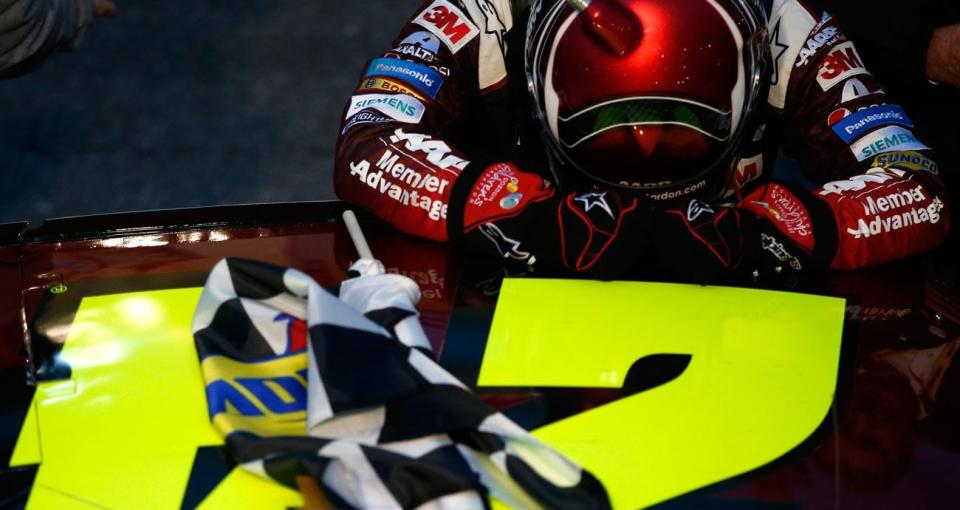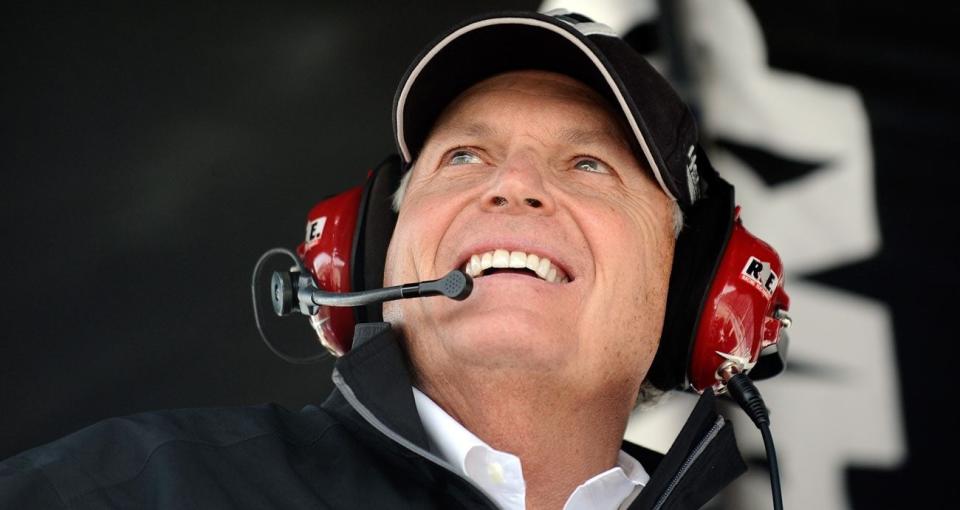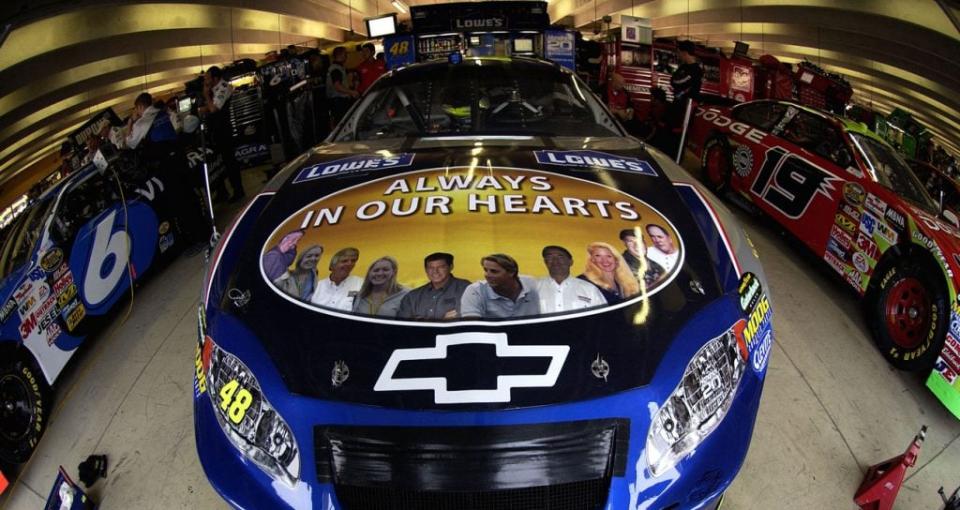Martinsville and Hendrick Motorsports, how triumph and tragedy formed the fabric of NASCAR's best team
CONCORD, N.C. — It was a timely reminder of Hendrick Motorsports and its inexorable connection to Martinsville Speedway.
As Alan Gustafson, crew chief for Chase Elliott, explained his team‘s long, fruitful and occasionally complicated relationship with the shortest oval on the Cup circuit, one of the track‘s famous grandfather clock trophies (among many on display inside the Hendrick Motorsports museum) suddenly was chiming in on the discussion.
Bong. Bong. Bong.
Gustafson, who guided Jeff Gordon to the final win of his career there in 2015 and a championship-saving win by Elliott there in 2020, smiled.
“I’m always optimistic going to Martinsville,” he said.
As he and anyone at Hendrick Motorsports should be after 28 Cup victories, the all-time single-track record for an organization.
For NASCAR‘s greatest team ever, Martinsville is synonymous with myriad moments that made its fame through some of its sweetest triumphs. But it also is stigmatized by one of the sport‘s deepest tragedies — an overwhelming heartbreak that could have broken anyone‘s spirit.
No track in NASCAR history has been more intertwined with a team‘s narrative arc.
As Rick Hendrick celebrates the 40th anniversary of starting a racing powerhouse, the 0.526-mile oval in Southwest Virginia brings all of his team‘s roots and rough edges into sharp relief.
It was at Martinsville where Hendrick Motorsports was saved by a Geoff Bodine victory on April 29, 1984 — the first win for a fledgling team of five employees that was within weeks of shutting its doors for good.
And it also was at Martinsville after a victory by Jimmie Johnson on Oct. 24, 2004 that the world learned a Hendrick Motorsports plane carrying key executives and family members had crashed en route to the race, killing all 10 aboard.
The devastating incident didn‘t derail the team, which won nine of the next 20 championships in a testament to its legendary adaptability and resilience.
Founded by the son of a Virginia tobacco farmer, Hendrick Motorsports often has been compared with the New York Yankees — NASCAR‘s version of an MLB standard-bearer. But this dynasty has been so good for so long in auto racing, a sport where setups, cars and rules have been known to change weekly.
“You just know that when you talk to Mr. Hendrick, there was a journey, there was a lot of work, a lot of grit to get to this point,” said Cliff Daniels, crew chief for Kyle Larson. “And to see him be able to enjoy this year makes it even that much more special. To know the heart and the soul that he and (Linda) Hendrick have poured into it makes it very sweet.
“Part of the reason that the success at Martinsville is so special is because of the tragedy at Martinsville, if that makes sense. When we tell stories about the race wins in Martinsville, it’s always a reminder of what happened on that day (of the plane crash). Yes, the first win was special and the Jimmie wins and the Jeff (Gordon) wins and the 1-2 finishes, but it’s also about what happened on that day. That’s a big part of the Hendrick story.”
That will be evident with the pomp and circumstance this weekend at Martinsville, where the team will run four shiny red cars in honor of its ruby anniversary and Bodine and Gordon will be the grand marshals. It’s also the only track where the owner’s four active drivers have all won.
But despite that success, there are no easy trips to a place where Hendrick’s brother, son and two nieces died trying to reach on a grim day 20 years ago.
“I think there‘s a lot of emotions that come with Martinsville for the boss and rightfully so,” Elliott said. “I couldn‘t imagine. It‘s been a place that has had a lot of highs and certainly the lowest of lows, and I think now you just try to honor the folks that we lost as best we can and try to carry forward things as they would want them to be.”
Said Gustafson: “It’s super polarizing when you go from the success on track, the key to the company’s existence, and then the attachment with the airplane crash and the pain and suffering that came with that.
“So that’s the polarizing thing about Martinsville. When you go there, you never forget, either.”

In its 41st season, Hendrick Motorsports has amassed a record 304 victories (three this season, including a 1-2 finish in its record-tying ninth Daytona 500 win), 14 championships and virtually every meaningful mark in NASCAR‘s premier series.
During just the past two of the four generations that NASCAR has existed, Hendrick has become the all-time leader in pole positions (248), top-10 finishes (more than 2,100) and laps led (more than 80,000). The team has won at least once in 38 consecutive seasons and at least three times in the past 30.
Over four decades, the team has excelled through countless iterations of intricate setups and the in-depth processes that govern their assembly.
How does it maintain such a level of sustained excellence? Ask any of its star crew chiefs and drivers, and the answer is the same.
“Mr. Hendrick.”
Gustafson believes the natural fixation on star drivers and their personalities leaves Hendrick‘s impact overlooked despite being NASCAR‘s all-time winningest car owner.
“He doesn’t get the credit he deserves for the example that he sets, the empathy that he has, the way he leads by example, motivates and empowers people,” Gustafson said. “How unselfish and humble he is. All those characteristics that you see of any of the good employees that have been through this place. I‘m not saying he’s the only reason, but he always is additive.
“Jeff Gordon, Jimmie Johnson, Chase Elliott and Kyle Larson are great people, but they’re better because they work for him. Significantly better. I feel that happens from the top to the bottom. Everybody I think is ultimately a better person and employee because of how he empowers you to do your job.”
In a method that borrows from his dealerships (where general managers are offered ownership stakes), Hendrick crew chiefs typically are promoted from within and are given tremendous autonomy over team direction.
Since joining the team three years ago, Larson has attended Hendrick dealership events “and I‘ve never seen anybody not smiling. Rick has over 10,000 employees throughout his companies, and everybody loves working for him. He‘s just a nice, normal person and a good guy.”
But while he might embrace policies to keep his employees happy, Hendrick also can be a hands-on manager willing to shake up his staff. After Johnson won his fifth consecutive Cup championship in 2010, Hendrick reshuffled the crew chiefs of his other three cars. Many of his personnel moves are more subtle.
“He’s just relentless in turning over every rock to make sure everybody has what they need to be successful,” Alex Bowman said. “I think sometimes something won’t make sense. And then you look at it a couple of months later, and it makes perfect sense.”
Joining Hendrick after a stretch of driving for journeyman-level operations, Bowman was initially confused by his new team‘s motivational luncheons with all-star speakers. (His personal favorite was David Goggins, a retired United States Navy SEAL.)
“I’m like, ‘What in the world is this? We’re all hanging out listening to this dude talk! We’re a race team,‘ ” the No. 48 Chevy driver said. “And a couple months later, I’m like, ‘That was really cool.‘ Just like everything he does has a purpose and I feel like everybody in the leadership positions here is that way.”
Said Daniels: “There’s moments a lot of us take for granted where it may just be he’ll buy lunch for the whole complex one day, come here and tell a story about the 1984 Martinsville race. He‘ll just engage with all of the folks, and that goes so far. His daily interaction with the people on the shop floor and his leadership are second to none.”
On the Thursday morning after William Byron became the sixth Hendrick driver to win the Daytona 500, Rick Hendrick rolled his Cadillac Escalade through his team‘s pit practice pad and personally thanked each No. 24 crew member. Byron said those pit stops are a good example of how the team adjusts to fix weaknesses, noting the team‘s vast improvement last season after a few off years.
“It always seems to cycle back, and that’s pretty amazing because no other race team has done that repeatedly year after year,” Byron said. “He’s just a phone call or one talk away from getting us back on track, and he’s always willing to do whatever it takes and figure out what the next emphasis is.”
The long-term vision was evident to Elliott from their first meeting when he was barely a teenager. Rick Hendrick picked up Bill and Chase Elliott at the airport and drove them to his team‘s campus, where he spent the day providing a guided tour of every building — from the chassis and engine shops to his 58,000-square-foot Heritage Center (which holds more than 120 Corvettes parked amid life-size re-creations of the touchstones from his childhood in Palmer Springs, Virginia, about two hours due east of Martinsville on the North Carolina border).
“I just appreciated how personal it was, and I’m sure he’s got much better things to do than tour a sophomore in high school around this facility,” Elliott said. “That’ll always stick with me. I got a guy telling me he wants to help me fulfill my dream at 14, 15 years old. I just took it with a grain of salt and make sure I just didn’t get my hopes up too much and ultimately have them shattered. But Rick is just the kind of guy that everything he says, he does.
“It starts with your leader, and we have a great one. Beyond that we are fortunate to have a lot of really good people in every respective department that wants to do their part, too.”

On its way to Martinsville nearly 20 years ago, a Beechcraft King Air 200 twin turboprop disappeared into the fog shrouding nearby Bull Mountain — and so did several inextricable links to Hendrick Motorsports‘ past, present and future.
The 10-passenger manifest included:
— Ricky Hendrick, the next-generation heir apparent to Hendrick Motorsports‘ founder;
— John Hendrick, who had run the team as its president while his older brother had recovered from leukemia and battled legal problems;
— Randy Dorton, widely regarded to be NASCAR‘s best engine builder;
— Jeff Turner, who had managed the team‘s day-to-day operations for two years.
Loss is an unfortunate byproduct of motorsports‘ inherent dangers, but this amount of grief sent shockwaves through the NASCAR industry. (“Like a hammer to the chest that takes the wind out of you,” Dale Earnhardt Jr. said at the time about the reaction.)
In the greatest example of his resolve, Hendrick wasted little time in restructuring his management, and the team hardly missed a beat — with Martinsville again serving as Exhibit A of its strength. Gordon and Johnson combined to win seven of the next nine races there after the plane crash.
Though only 8 years old when the accident happened, Elliott has raw memories of its aftermath, and the emotions deepened after he joined the team.
“You probably don’t appreciate just all the details and respect that type of loss as when you get a little older and then especially to understand now just how much of a family environment this is here,” he said. “That made it even that much more devastating as I’ve become a part of that family over the years.”
Larson said the tragedy isn‘t discussed much internally, but he understood what Martinsville meant before driving for Hendrick.
“It‘s ironic that a place that’s been so good to them but also terrible to them has been their most successful,” Larson said. “It‘s always on everybody‘s minds anytime we get ready to go to Martinsville. I hoped I would win there to add to the legacy.”
He broke through last year in an emotional win for him and Daniels, who first went to Martinsville as an infant while his dad was racing Late Models.
“That was always a dream to come be here to be a part of this team, this organization one day,” said Daniels, who hails from Smithfield in the Tidewater area near Norfolk.
He is one of many Virginia natives raised to attend races at Martinsville long before winning them for Hendrick — another motivating factor for the team being such a force at the track.
Before becoming Bowman‘s crew chief, Blake Harris “spent a lot of years trying to beat those guys at Martinsville and to go outrun a Hendrick car took everything we had.”

Byron fondly recalls watching at least three Hendrick wins as a fan in the Martinsville grandstands (notably Johnson outdueling Gordon in an intrasquad slam-bang battle in 2007).
“I would always watch in Turn 1, and those cars would come by and hit the chip, and they would set so nicely on the brakes,” Byron said. “They would always be P1 or P2 off the truck. You knew Hendrick cars at Martinsville was what you wanted to drive.”
He maximized his opportunity with a win there in 2022, experiencing the “deep” history with the team during the exuberant celebration.
“It kind of just felt like I had finally done something that was worthy of recognition at Hendrick,” Byron said. “To win a grandfather clock puts you on a list with guys that have won a lot of races. That was one of my biggest wins because it‘s a race track that’s really important to this place.”
But of course, it‘s not just because of the victories.
Byron also noted the “Always in Our Hearts” tribute graphics that still adorn Hendrick‘s cars to memorialize those lost in the 2004 plane crash.
“I think every year Martinsville comes around, it’s never forgotten,” he said. “Understanding the history and all that Mr. H and Linda has gone through there.
“It’s a really important race track.”
Nate Ryan has written about NASCAR since 1996 while working at the San Bernardino Sun, Richmond Times-Dispatch, USA TODAY and for the past 10 years at NBC Sports Digital. He is the host of the NASCAR on NBC Podcast and has covered various other motorsports, including the IndyCar and IMSA series.

